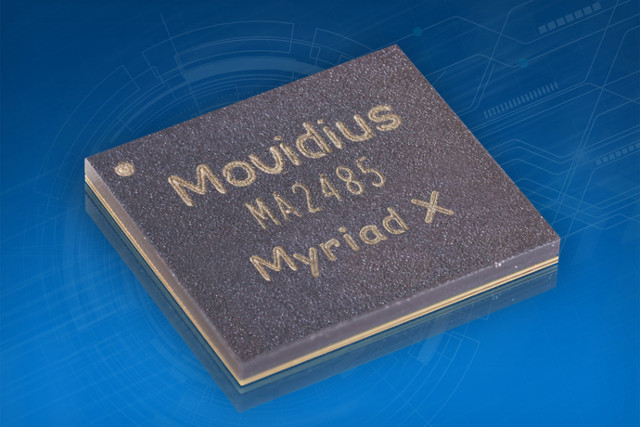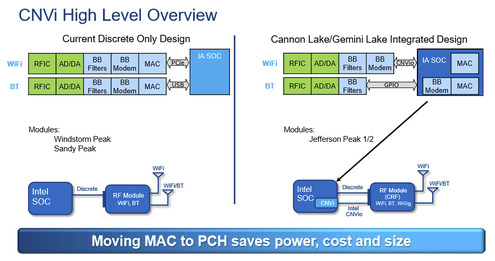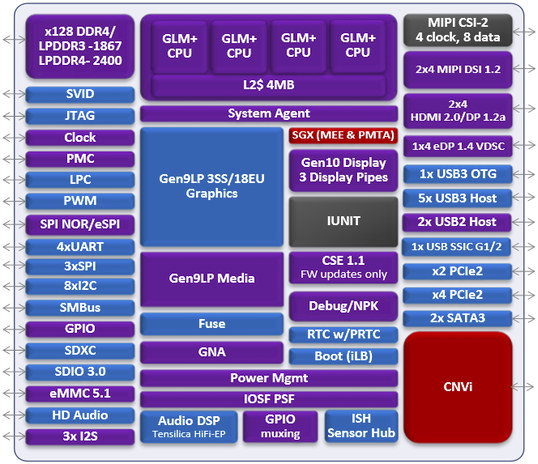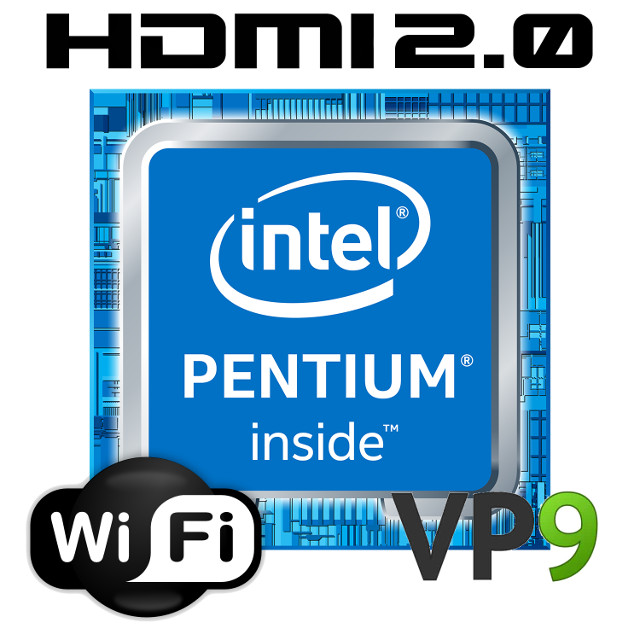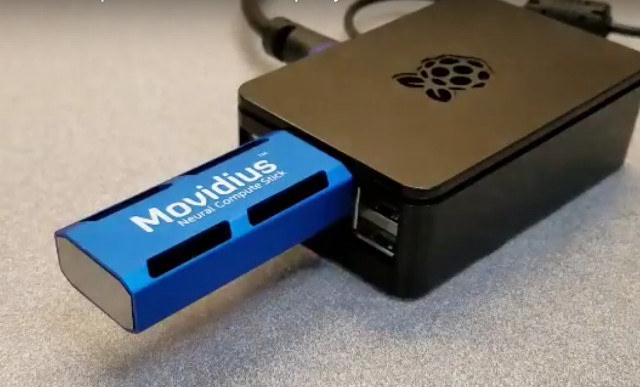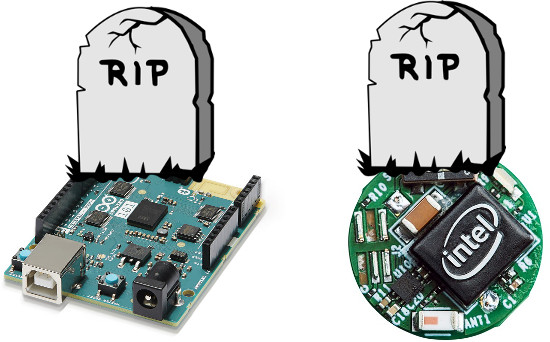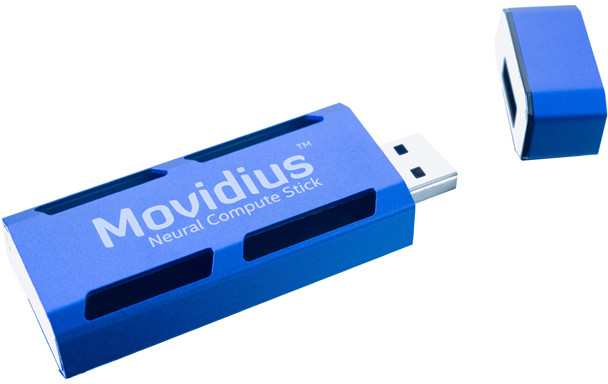Intel has just announced the third generation of Movidius Video Processing Units (VPU) with Myriad X VPU, which the company claims is the world’s first SoC shipping with a dedicated Neural Compute Engine for accelerating deep learning inferences at the edge, and giving devices the ability to see, understand and react to their environments in real time. Movidius Myraid X VPU key features: Neural Compute Engine – Dedicated on-chip accelerator for deep neural networks delivering over 1 trillion operations per second of DNN inferencing performance (based on peak floating-point computational throughput). 16x programmable 128-bit VLIW Vector Processors (SHAVE cores) optimized for computer vision workloads. 16x configurable MIPI Lanes – Connect up to 8 HD resolution RGB cameras for up to 700 million pixels per second of image signal processing throughput. 20x vision hardware accelerators to perform tasks such as optical flow and stereo depth. On-chip Memory – 2.5 MB homogeneous […]
Intel Wireless-AC 9560 CRF Module Adds 802.11ac WiFi and Bluetooth 5 to Gemini Lake/Cannon Lake Processors
Last week, we saw that the upcoming Intel Gemini Lake processors integrated a CNVi (Connectivity Integration) block with a WiFi MAC, and Bluetooth MAC & Baseband Modem connected over a CNVio interface to a separate CRF (Companion RF) module handling the RF part. The design change is shown in the block diagram below with the old design on the left using wireless modules connected over PCIe and USB, and the new design on the right used in Cannon Lake/Gemini Lake processors which aims at saving power, cost, and size. Intel has now uploaded the product brief for their first wireless CRF module: Intel Wireless-AC 9560 with the following key features: Connectivity WiFi Dual band 802.11 a/b/g/n/ac wave 2 2×2 WiFi up to 1.73 Gbps using 160 MHz channels Standards – IEEE 802.11a/b/g/n/ac, 802.11d, 802.11e, 802.11h, 802.11i, 802.11w, 802.11r, 802.11k, 802.11v pending OS support Security WPA and WPA2, 802.1X (EAP-TLS, TTLS, […]
Intel Gemini Lake Block Diagram and Yet More Info
So yesterday, I wrote about some of the new features of Intel Gemini Lake processors like native HDMI 2.0, 4-wide pipeline, 10-bit VP9, and possible built-in 802.11ac wireless controller. I went to bed, and somehow this morning I woke up with something that looks like Gemini Lake (GLK) block diagram, and a few more details. So we indeed have HDMI 2.0 output, as well as DP 1.2a and eDP 1.4, and an embedded wireless controller via the CNVi (Connectivity Integration Architecture) block for WiFi’s MAC and Bluetooth’s MAC + Baseband modem. We’ll have plenty of USB 3.0 host interfaces, and the usual PCIe and SATA 3 interfaces. Still no UFS support, but eMMC 5.1 is supported, as well as x128 DDR4, LPDDR3 and LPDDR4 memory up to 2400 MHz (No ECC support). Cache size is confirmed to be 4MB for up to four GoldMont Plus (GLM+) cores, which combined with […]
New Features of Intel Gemini Lake Processors – HDMI 2.0, 10-bit VP9 Codec, 4-Wide Pipeline, and More
Most recent low power Intel mini PCs are now based on Apollo Lake family with SoC such as Celeron N3450 or Pentium N4200, but we’ve known for a while that Gemini Lake processors will succeed those starting in Q4 2017, and we can expect some Celeron/Pentium SKUs like Intel Pentium J5005 or Intel Celeron N4000, but so far I had not seen that many details. However, an anonymous tip pointed me to some interesting publicly available information. First, a kernel patch reveals a little about the CPU pipeline: Add perf core PMU support for Intel Goldmont Plus CPU cores: – The init code is based on Goldmont. – There is a new cache event list, based on the Goldmont cache event list. – All four general-purpose performance counters support PEBS. – The first general-purpose performance counter is for reduced skid PEBS mechanism. Using :ppp to indicate the event which want […]
Movidius Neural Compute Stick Shown to Boost Deep Learning Performance by about 3 Times on Raspberry Pi 3 Board
Intel recently launched Movidius Neural Compute Stick (MvNCS)for low power USB based deep learning applications such as object recognition, and after some initial confusions, we could confirm the Neural stick could also be used on ARM based platforms such as the Raspberry Pi 3. Kochi Nakamura, who wrote the code for GPU accelerated object recognition on the Raspberry Pi 3 board, got hold of one sample in order to compare the performance between GPU and MvNCS acceleration. His first attempt was quite confusing as with GoogLeNet, Raspberry Pi 3 + MvNCS achieved an average inference time of about 560ms, against 320 ms while using VideoCore IV GPU in RPi3 board. But then it was discovered that the “stream_infer.py” demo would only use one core out of the 12 VLIW 128-bit vector SHAVE processors in Intel’s Movidius Myriad 2 VPU, and after enabling all those 12 cores instead of just one, […]
Intel’s Movidius Neural Compute Stick Supports Raspberry Pi 3 Board
Last month, Intel introduced Movidius Neural Computer Stick to accelerate applications such as object recognition, and do so offline, i.e. without the cloud, and at low power. While there was not that much information available at the time, the minimal requirements for the host machine were that it had to be a x86_64 computer running Ubuntu 16.04, and come with at least 1GB RAM, and 4GB storage. So I understood the stick would only work attached with 64-bit Intel or AMD processors, and ARM development boards would not be an option. But today, I’ve found that Movidius had uploaded a new video showing a Python based object recognition demo with the Neural Compute Stick connected to the the Raspberry Pi 3 board. You just need to add a USB camera, copy ncapi directory from the SDK installed on your Ubuntu 16.04 development machine to the Debian Jessie installed on RPi 3 […]
Intel Curie Module, Arduino 101 Board Are Being Discontinued (Too)
Intel seems to have completely given up on its efforts to bring products specific to the Internet of Things. After discontinuing Intel Edison, Galileo and Joule boards & modules last month, forcing companies to look for alternatives, the company has now issued product discontinuance / end-of-life notices for Intel Curie Module and Arduino 101 board, itself based on the Curie module. The two product change notification notice can be found below for: Select Intel Curie Module Products – PDF Select Intel Arduino 101 Products – PDF The use of the word “Select” would normally mean some versions of the module and board won’t be affected, but I fail to see which ones here, as AFAIK there’s only one Arduino 101 board, and two variants of Curie modules, all three to be discontinued. Arduino 101 will be phased out faster with the following milestones: July 17, 2017 – Product Discontinuance Program […]
Intel’s Movidius Neural Compute Stick Brings Low Power Deep Learning & Artificial Intelligence Offline
Intel has released several Compute Stick over the years which can be used as tiny Windows or Linux computer connected to the HDMI port of your TV or monitor, but Movidius Neural Computer Stick is a complete different beast, as it’s a deep learning inference kit and self-contained artificial intelligence (A.I.) accelerator that connects to the USB port of computers or laptops. Intel did not provide the full hardware specifications for the kit, but we do know the following specifications: Vision Processing Unit – Intel Movidius Myriad 2 VPU with 12 VLIW 128-bit vector SHAVE processors @ 600 MHz optimized for machine vision, Configurable hardware accelerators for image and vision processing; 28nm HPC process node; up to 100 gigaflops USB 3.0 type A port Power Consumption – Low power, the SoC has a 1W power profile Dimensions – 72.5mm x 27mm x 14mm You can enter a trained Caffe, feed-forward […]


